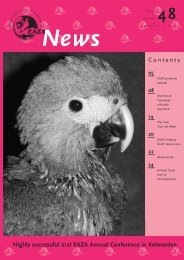EAZA News 58-9 - European Association of Zoos and Aquaria
EAZA News 58-9 - European Association of Zoos and Aquaria
EAZA News 58-9 - European Association of Zoos and Aquaria
Create successful ePaper yourself
Turn your PDF publications into a flip-book with our unique Google optimized e-Paper software.
Approximately 500,000 larvae transported in plastic bottles photos sabine joosten<br />
Important natural resources<br />
Invariably, these problems all originate from human exploitation <strong>of</strong> the<br />
forest regions, both directly <strong>and</strong> indirectly. Probably the greatest threats<br />
are livestock grazing <strong>and</strong> logging for firewood <strong>and</strong> timber production.<br />
These activities lead to the degeneration <strong>of</strong> indigenous vegetation,<br />
causing reduced biodiversity <strong>and</strong> soil erosion. Forests in northern Africa<br />
also play a vital role in creating shade, regulating the hydrology <strong>of</strong> the<br />
area <strong>and</strong> providing drinking water. The trees retain the soil, <strong>and</strong> generate<br />
cooler <strong>and</strong> wetter microclimates for plants, animals <strong>and</strong> humans. Reduced<br />
rain <strong>and</strong> snowfall have led to severe droughts since the 1990’s. There is a<br />
deleterious effect on the Moroccan water supply, 60% <strong>of</strong> which is provided<br />
by the Middle Atlas forest. Climate change is already <strong>and</strong> will only<br />
progressively stress the already degraded ecosystem. The consequences<br />
are potentially disastrous for both animals, such as the Barbary macaque,<br />
<strong>and</strong> local communities depending heavily on the forest resources.<br />
The <strong>European</strong> link<br />
Apart from being a local problem, the Barbary macaque can actually be<br />
considered a true ‘<strong>European</strong> issue’ for several reasons. The close economic<br />
<strong>and</strong> cultural connections between northern Africa <strong>and</strong> Europe links us<br />
to the macaques' countries <strong>of</strong> origin. The Barbary macaque is the only<br />
primate species close to Europe (once even an inhabitant <strong>of</strong> part <strong>of</strong><br />
Europe), <strong>and</strong> an introduced feral population <strong>of</strong> a few hundred animals<br />
lives on the Rock <strong>of</strong> Gibraltar. An estimated 300 animals are caught from<br />
the wild annually for the illegal pet trade into Europe. Captive-bred<br />
populations are kept in many <strong>European</strong> zoological institutions. Knowing<br />
that Barbary macaques in northern Africa <strong>and</strong> their natural habitat are<br />
currently <strong>of</strong>fered very limited protection, despite their low numbers <strong>and</strong><br />
rapid decline, it seems logical to become involved in the protection <strong>of</strong> this<br />
unique species.<br />
Current conservation measures<br />
Though most habitats <strong>of</strong> the Barbary macaque in Algeria benefit from a<br />
national park status, in Morocco the largest part <strong>of</strong> their habitat falls<br />
outside <strong>of</strong> protected areas. There are however serious plans to give<br />
protected area status to the central Middle Atlas. As a CITES II species,<br />
the collection <strong>and</strong> export <strong>of</strong> macaques are regulated by a system <strong>of</strong><br />
permits in both Morocco <strong>and</strong> Algeria, but enforcement <strong>of</strong> the legislation<br />
is minimal. As the trade was thought to have a harmful effect on the<br />
survival <strong>of</strong> the species, imports into the EU were suspended in 2000<br />
under the provisions <strong>of</strong> article 4.6b <strong>of</strong> EC Regulation 338/97.<br />
conservation<br />
These remain in force under the most recent EC suspensions regulation<br />
EC252/2005. In effect these measures have no influence on the active<br />
illegal trade. The limited protection measures unambiguously pose a<br />
direct threat to the survival <strong>of</strong> the species.<br />
Action is needed<br />
Through cooperation on a practical <strong>and</strong> political level it seems that a<br />
change for the better is in sight. Local <strong>and</strong> international research is providing<br />
a lot <strong>of</strong> information on the harmful developments in Barbary macaque<br />
habitat such as the Middle Atlas. IUCN, WWF, the Moroccan Ministry <strong>of</strong><br />
Forest <strong>and</strong> Water <strong>and</strong> many specialists in the field have identified the causes<br />
<strong>of</strong> the problems, <strong>and</strong> more importantly, the proper solutions. Various<br />
measures have been recommended to reduce the chances <strong>of</strong> the Barbary<br />
macaque becoming extinct, <strong>and</strong> turning around unsustainable human<br />
l<strong>and</strong> use in north Africa. Action points discussed include creating a management<br />
plan for conservation <strong>and</strong> sustainable development, the strict<br />
enforcement <strong>of</strong> national park guidelines, increased forest guard activities,<br />
upgrading CITES listing <strong>of</strong> the Barbary macaque, better enforcement <strong>of</strong><br />
the CITES laws, strict border control <strong>and</strong> assisting local communities to<br />
implement an alternative economy to livestock keeping. Over the next<br />
few years a great deal <strong>of</strong> attention needs to be devoted to putting these<br />
strategies into practice.<br />
Raising awareness <strong>and</strong> educating both the local <strong>and</strong> international community<br />
is the key to gathering the support needed to successfully achieve<br />
these goals. This is where pr<strong>of</strong>essional organisations such as <strong>EAZA</strong> can make<br />
a considerable contribution. The Barbary macaque in captivity can be used<br />
as an ambassador, illustrating how we need to promote sustainable use<br />
<strong>of</strong> our nearby natural resources. We must help to safeguard the long-term<br />
survival <strong>of</strong> these unique <strong>and</strong> valuable regions such as the Middle Atlas<br />
Mountains, for the benefit <strong>of</strong> both humans <strong>and</strong> animals. •<br />
Barbary macaques are being monitored by the <strong>EAZA</strong> Old World Monkey<br />
TAG. Currently, ISIS lists 102.146.37 Barbary macaques in <strong>EAZA</strong> institutions.<br />
However, much more animals are held at non-<strong>EAZA</strong> institutions<br />
<strong>and</strong>/or non-ISIS institutions, <strong>and</strong> it might well be that the Barbary<br />
macaque is the most commonly kept primate in captivity in Europe.<br />
This article has been abridged <strong>and</strong> the references were left out due to space limitations. For the original full version <strong>of</strong> the article including reference details, please refer to the ‘Magazine’ section <strong>of</strong> the <strong>EAZA</strong> website.<br />
eaza news <strong>58</strong><br />
2007<br />
29

















